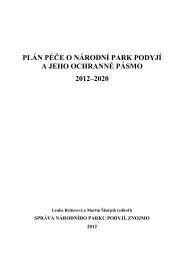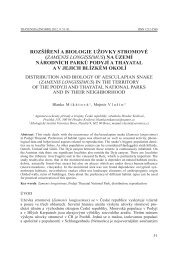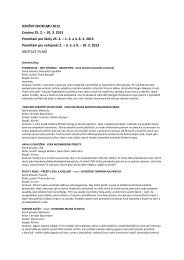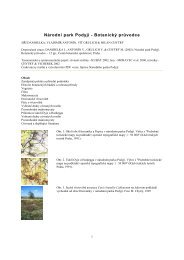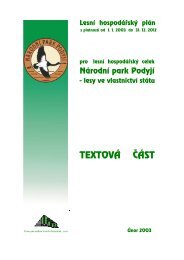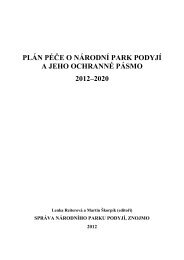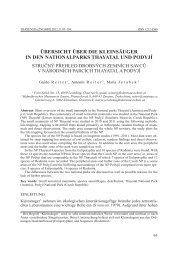Thayensia supplementum I. - Národnà park PodyjÃ
Thayensia supplementum I. - Národnà park PodyjÃ
Thayensia supplementum I. - Národnà park PodyjÃ
Create successful ePaper yourself
Turn your PDF publications into a flip-book with our unique Google optimized e-Paper software.
Pulicaria vulgaris, Pyrola chlorantha, Sideritis montana, Taraxacum bessarabicum,<br />
Torilis arvensis, Triglochin palustre, Vaccaria hispanica subsp. grandiflora, Viola suavis).<br />
Podrobnější analýza, hodnotící vývoj jednotlivých biotopů a jejich flóry na základě<br />
srovnání Drlíkovy Květeny Znojemska s poznatky jeho předchůdců a následovníků, je<br />
ovšem nad rámec tohoto krát ké ho shrnutí a bude předmětem podrobnější studie.<br />
Jako samostatně bádající amatér Drlík evidentně neměl možnost konzultovat svá<br />
určení se specialisty. Je to celkem zřejmé z úrovně jeho determinací. Některé skupiny<br />
mu zřejmě byly bližší, takže v nich není mnoho determinačních omylů, zatímco v jiných<br />
se dopouštěl až školáckých chyb (např. při určování některých rostlin lipnicovitých).<br />
Tyto omyly mu dnes nelze vyčítat. Naopak, Drlíkova snaha o důsledné shromažďování<br />
herbářových do kla dů je mimořádně cenná a právě konfrontace sbírkového fondu<br />
s textem rukopisu umožňuje dnešní kritický pohled na jeho odkaz.<br />
SUMMARY<br />
The manuscript of the “Květena Znojemska 1950–1954” was written by the first of the authors and<br />
has not been published so far. After the manuscript had been discovered in the family archive, the<br />
present co-authors translated it into the digital form and prepared it to be published (its original form<br />
is shown in Figs. 1 and 2). In his manuscript, Vratislav Drlík joins up mainly with scientists who lived<br />
in Znojmo, above all, Adolf Oborny (1840–1924) who was professor at the Znojmo gymnasium for<br />
many years. This late scien tist is the author of a work named “Die Flora der Znaimer Kreises” (OBORNY<br />
1879) and a critical work on the “Flora von Mähren und österr. Schlesien” (OBRONY 1883–1886) which<br />
was very modern at its time. It is very in te re sting to note that Drlík worked with another book on the<br />
flora of the Znojmo region whose main protagonist was Wolf gang Him mel baur, private university<br />
teacher in Vienna (HIM MEL BAUR & STUMME 1923). Although both cri ti cal and very valuable in retrospective<br />
points of view, this work was practically unknown to the Cze cho slo va ki an bo ta nists before<br />
World War II. For example, it was not mentioned even in the contemporary botanical bibliography<br />
(FUTÁK & DOMIN 1960). Furthermore, Drlík joins up with the studies by O. To mas chek, published in<br />
the periodical „Natur und Heimat“, the major natural history forum of the Sudetic Ger mans, published<br />
in Ústí nad Labem (TOMASCHEK 1933, 1935).<br />
For the identification of plant species, Drlík chiefly used the work by LAUS (1908) and, in a limited<br />
extent, the most widespread key published during the first Czechoslovakian republic (POLÍVKA et al.<br />
1928). He also considered the flora written by Dostál to be of importance (DOSTÁL et al. 1948–1950)<br />
and often refers the reader to its sim pli fying and often somewhat distorted geographic information.<br />
It is surprising to note the author’s isolation from the Brno scientific centre, as during the first<br />
Cze cho slo va ki an Republic this centre issued a large number of papers at least partly pertaining to<br />
the Znojmo region. This is true, first of all, of the fragmentary “Květena Moravy“ (Flora of Moravia)<br />
(PODPĚRA 1926–1930), only oc ca si o nal ly cited by Drlík. It is also worth mentioning the numerous<br />
studies of Suza. Suza was not only the author of the term Praebohemicum, denoting the whole region<br />
under the present study, but also treated its botanical pe cu li a ri ties in a monograph published in<br />
the Botanisches Centralblatt, the international periodical issued in Dresden, Germany (SUZA 1935).<br />
From among the disciples of the Brno botanical school, Drlík only quotes, in several cases, František<br />
Švestka, who after World War II was active for a short time as scho ol mas ter in the Znojmo region.<br />
Several studies by Anton Fröhlich, schoolmaster at Mikulov (e.g. FRÖH LICH 1930, also pertain to this<br />
region. However, Drlík probably did not even know Fröhlich’s papers.<br />
Drlík’s main activity area was the southern part of the present Znojmo Region; he had very scant<br />
data from the area north of the Jevišovka River (the areas around Miroslav and Moravský Krumlov).<br />
Sur pri sing on the one hand yet understandable on the other is the fact that Drlík’s text lacks his own<br />
direct observations in the area lying close at the boundary between Czechoslovakia and Austria. At<br />
the time Drlík worked in that area, access to the border zone was already rather complicated. From<br />
the Dyje River valley, lying in the present Podyjí National Park, Drlík recorded several species only<br />
278



